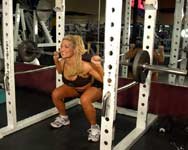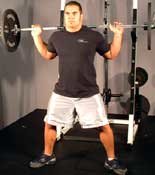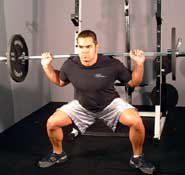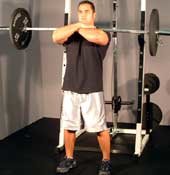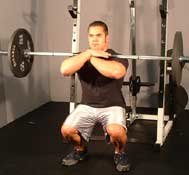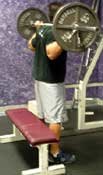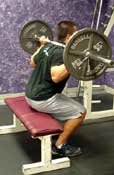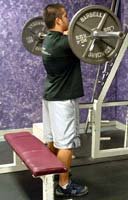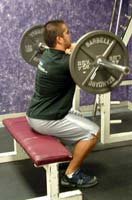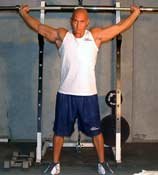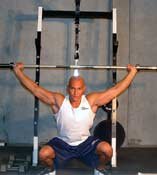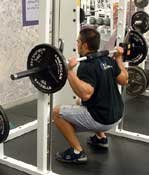
Introduction

A barbell squat is a push-type, compound exercise which works primarily your quadriceps, but also trains your glutes, hamstrings, and calves, as well as muscles in your lower back. The following table lists general information about barbell squats and the muscles that you use when performing barbell squats.
| Basic Exercise Data For Barbell Squats | |
| Resistance | Barbell + Weight |
| Mechanics Type | Compound |
| Force Type | Push |
| Targeted Muscles | Quadriceps |
| Synergists | Gluteus Maximus, Adductor Magnus, Soleus |
| Dynamic Stabilizers | Hamstrings, Gastrocnemius |
| Stabilizers | Erector Spinae |
| Antagonist Stabilizers | Rectus Abdominis, Obliques |
In preparation for performing barbell squats, position an empty barbell on a squat rack at a height that's about 3-5 inches lower than your shoulders. Position the spotter rails at a height that won't interfere with the barbell when you lower the weight.
Load an equal amount of weight on each side of the barbell and secure the weight plates to the barbell. It's also a good idea to make certain that there aren't any loose plates or other objects laying around that will interfere with barbell during squats.
You can perform a regular barbell squat by stepping squarely under the barbell and placing it in contact with your shoulder-girdle. Be sure you don't place the bar on your neck.
The bar should be held in place by your shoulders. If this is uncomfortable, you can use a towel or other padding to cushion the bar. The bar will become less uncomfortable as you get used to doing squats.
Another thing to take note of is that the bar should be centered on your back. This is important: an uncentered bar will cause you to lift more weight with one leg than the other! Another way to make sure that the weight is evenly dispersed across your back is to clip a Manta Ray (TM) onto the barbell.
Once you've positioned the bar on your upper back, grasp the bar firmly with your hands. It's a good idea to position your hands so that they're separated by a distance at least twice your shoulder-width.
Spacing your hands too close together can lead to straining of your shoulders, which may cause you problems when you perform other exercises, such as the bench press.
With the barbell centered on your shoulder-girdle, use your legs to lift the barbell off the rack and then step back just enough to perform the exercise without bumping into the rack, as shown in Figure 1. You can position your feet about shoulder-width apart with your feet and knees pointing outward a bit.
Never squat with your feet pointing directly forward; your quadriceps muscles contract more efficiently when your feet (and knees) are pointing outward a little bit. You can place your heels on a 1-1.5 inch block to further emphasize your quads.
Try to avoid taking up too much time fidgeting with foot position while the weight is on your back; more squatting injuries occur during racking and unracking the bar than during the actual exercise itself!
Once your hands and feet are suitably positioned, you can perform the barbell squat by bending your knees and allowing your upper body to descend under control until your thighs are about parallel with the floor, as shown in Figure 2. Next, vigorously push the weight upwards until you reach the initial position, shown in Figure 1.
Avoid letting your balance shift forward or backward, and keep your back as straight as possible throughout the lift. This is important: rounding your back under load can injure your lower back.
Focus on keeping your abs tightened throughout the exercise--this provides support to your lower back. When the weight is extremely heavy you can use a Lifting Belt to provide further support to your lower back.
Alternatively, some lifters prefer to perform "full barbell squats" where the weight is lowered until the knees and hips are fully bent, as shown in Figures 3-4.
Some lifters think this is the best way to fully stimulate the quadriceps while others think this is potentially damaging to the knees and lower back. The best advice, however, is to lower the weight to a depth that allows you to keep your back straight throughout the exercise, and does not traumatize your knees. Broadly speaking, this depth typically coincides with placing the thighs roughly parallel with the floor, as mentioned above.
Now that you know how to perform regular barbell squats, let's take a look at some of the many popular variations of barbell squats.
 Wide Barbell Squats
Wide Barbell Squats
A variation of squats that emphasizes the inner thighs is a wide barbell squat. Performing a wide barbell squat is nearly identical to performing a regular barbell squat, with the exception that you place your feet about 30 inches apart, as shown in Figures 5-6.
As with regular squats, when you perform wide barbell squats your feet should be pointing outward a bit to allow the quadriceps to contract with maximum efficiency.
When you perform a wide barbell squat, bend your knees and allow your upper body to descend under control until your thighs are about parallel with the floor, as shown in Figure 6, and then push the weight upwards under control until you reach the initial position, shown in Figure 5.
Remember to keep your back as straight as possible throughout the lift. Rounding your back under load can injure your lower back! Focus on tightening your abs to support to your lower back.
 Front Barbell Squats
Front Barbell Squats
-
A front barbell squat is another way to perform barbell squats except that you place the barbell on your upper chest with the barbell resting on your front deltoids and upper thorax, as shown in Figures 7-8.
To hold the barbell in place, cross your arms and position your right hand on top of the bar near your left shoulder and position your left hand on top of the bar near your right shoulder.
Keep your upper arms slightly above parallel with the floor to prevent the bar from sliding, and position your feet at about shoulder-width with your feet and knees pointing outwards a bit.
-
You can perform the front barbell squat by bending your knees and allowing your upper body to descend under control until your thighs are about parallel with the floor, as shown in Figure 7. Once you reach the final position shown in Figure 8, slowly push the weight upwards until you reach the initial position, shown in Figure 7.
Don't let your balance shift forward or backward, and keep your back as straight as possible throughout the lift. Also, concentrate on keeping your abs tightened throughout the lift to support to your lower back. The following table lists the muscles worked during front barbell squats.
| Muscles Worked With Front Barbell Squats | |
| Targeted Muscles | Quadriceps |
| Synergists | Gluteus Maximus, Adductor Magnus, Soleus |
| Dynamic Stabilizers | Hamstrings, Gastrocnemius |
| Stabilizers | Erector Spinae, Deltoids (Anterior, Lateral), Supraspinatus |
| Pectoralis Major, Trapezius, Levator Scapulae | |
| Serratus Anterior | |
| Antagonist Stabilizers | Rectus Abdominis, Obliques |
 Squat to Bench (Box Squats)
Squat to Bench (Box Squats)
-
One way to be certain that you're squatting to the same depth on every repetition is to perform squats to a bench, also referred to as Box Squats, as shown in Figures 9-10.
Box squats are substantially identical to regular barbell squats, with the exception that you position a flat bench or a box behind you to signal to you when you've squatted to the desired depth.
When you perform box squats, position the barbell on your shoulder girdle as described above, and then position yourself near a bench, or box, as shown in Figure 9. Descend under control until you feel the bench touching you, as shown in Figure 10, then push the weight upwards until you reach the initial position again.
Never sit or rest on the bench with the weight on your back! Also, remember to keep your back as straight as possible and your abs tightened throughout the lift.
You can also perform front squats to a bench or box, as shown in Figures 11-12. Performing front box squats is the same as performing regular front barbell squats, discussed above. When you descend, be sure that you touch the bench just enough to signal that you've reached the desired depth--never sit or rest on the bench with the weight on your back!
 Barbell Hack Squats
Barbell Hack Squats
-
A barbell hack squat is a variation of barbell squats where you hold the barbell behind you at arm's length. When you prepare to perform barbell hack squats, assume a shoulder-width stance and bend down and grasp the bar with an overhand grip.
Your grip should be about as wide as your hips. Turn your wrists up to secure your grip on the bar. Be sure to maintain this grip throughout the lift.
While keeping your back as straight as possible and looking straight ahead, push the weight upward until you reach the final position shown in Figure 14. In the final position, the bar will be pressing against your upper thighs.
As you continue squatting, descend to a depth where your thighs are roughly parallel to the floor. The following table lists the muscles that are worked during barbell hack squats.
| Muscles Worked With Barbell Hack Squats | |
| Targeted Muscles | Quadriceps |
| Synergists | Gluteus Maximus, Adductor Magnus, Soleus |
| Dynamic Stabilizers | Hamstrings, Gastrocnemius |
| Stabilizers | Erector Spinae, Trapezius (Upper, Middle), Levator Scapulae |
| Antagonist Stabilizers | Rectus Abdominis, Obliques |
 Overhead Squats (Snatch Grip Squats)
Overhead Squats (Snatch Grip Squats)
-
Another variation of barbell squats is an overhead squat, also called a snatch grip squat. With this type of squat, you place the barbell over your head using a snatch grip with your arms locked, as shown in Figures 15-16. Your stance ought to be wide with your toes pointing outward in the receiving position for the snatch.
When you squat, descend until your thighs are below parallel with the floor, as shown in Figure 16. Keep your feet flat on the floor and keep your eyes straight ahead.
Also, maintain an upright posture with your back tight and chest lifted throughout the exercise. Avoid leaning forward at the waist and allowing your hips to push backward. Since you could fall over with the weight, you should consider this exercise dangerous, and thus you should seriously consider having a spotter assist you.
 Smith Machine Squats
Smith Machine Squats
A popular machine variation of regular barbell squats is the Smith Machine Squat, shown in Figures 17-18. Performing Smith Machine Squats is identical to performing regular barbell squats, with the exception that with the Smith Squats the barbell rides along vertical rails mounted on the rack and has safety locks.
Although using safety locks and having the barbell secured to the rails makes Smith Squats safer than regular barbell squats, Smith Squats may not be as effective as regular barbell squats because Smith Squats don't utilize your stabilizer muscles quite as much.

Incorporating Barbell Squats Into Your Training

Now that you know how to perform various forms of barbell squats, let's take a brief look at some ways to incorporate squats into your training.
Since all forms of barbell squats are pushing exercises that work your quadriceps, it's a good idea to combine squats with exercises that train your hamstrings. For example, one choice is to combine barbell squats with leg curls.
Another option is to combine barbell squats with stiff-leg deadlifts, which also work the hamstrings. Following is one example of a full-body routine which pairs barbell squats with leg curls.
Now let's take a look at an abbreviated routine that affords more time for greater training volume.
| Abbreviated Routine |
| Squat |
| Stiff-Leg Deadlifts |
| Bench Press |
| Wide-Grip Pull-ups |
| Close-Grip Bench Press |
| Barbell Curls |
| Shrugs |
 Click Here For A Printable Log Of This Abbreviated Routine Click Here For A Printable Log Of This Abbreviated Routine |
As you can see, squats are paired with stiff-leg deadlifts. The squats work the quadriceps, and the stiff-leg deadlifts work the hamstrings.
Another popular approach is to select alternating exercises that are performed every other workout day. For example, you might choose the following alternatives for a full-body workout.
| Alternative Full Body Workouts | ||
| Workout A. | Workout B. | |
| Squat | Leg Press | |
| Leg Curl | Stiff-Leg Deadlifts | |
| Inc. Bench Press | Dips | |
| Chins | Rows | |
| Rear Delts | Rear Delts | |
| Triceps Extensions | Close-Grip Bench Press | |
| Barbell Curls | Drag Curls | |
| Shrugs | Shrugs | |
| Calf Raise | Calf Raise | |
In this routine, exercises A are performed on one workout day, exercises B are performed on the next workout day, and so on. Notice that squats are alternated with the leg press, and leg curls are alternated with stiff-leg deadlifts.
Many lifters prefer to split up their training so that different body parts are trained on different workout days.
Splitting up your training enables you to more thoroughly concentrate on specific muscle groups with more exercises and/or more training volume, as well as giving those muscle groups more recovery time than would be otherwise possible.
Following is one example of 4-way split, wherein different body parts are trained on four different workout days each week.
| Monday | Tuesday | Thursday | Friday |
| (Legs) | (Chest/Triceps) | (Back/Biceps) | (Shoulders/Traps) |
| Squats | Inclined Bench Press | Wide-Grip Pull-ups | Shoulder Press |
| Leg Press | Dips | Rows | Lateral Raise |
| Stiff-Leg Deadlifts | Pec Deck | Barbell Curls | Rear Delt Raise |
| Leg Curls | Triceps Pushdowns | Dumbbell Preacher | Shrugs |
| Calf Raise | Triceps Extensions | Curls | |
| Abdominal Crunches | |||
 Click Here For A Printable Log Of Monday.
Click Here For A Printable Log Of Monday.
 Click Here For A Printable Log Of Tuesday.
Click Here For A Printable Log Of Tuesday.
 Click Here For A Printable Log Of Thursday.
Click Here For A Printable Log Of Thursday.
 Click Here For A Printable Log Of Friday.
Click Here For A Printable Log Of Friday.
As you can see, with this 4-way split exercises that work the legs have their own training day. Doing this not only allows you to use more exercises for your legs, but also allows you to concentrate on training your legs by using more training volume.
Moreover, splitting up your training gives your legs an entire week to recover before being trained again.

Alternatives To Performing Barbell Squats 
Needless to say, the barbell squat is a great exercise; anyone who's serious about his/her training should be squatting. Despite this directive, however, squatting isn't for everyone.
For example, trainees having existing lower back pathology may find squats painful. Any exercise which causes pain beyond normal muscle soreness should be discontinued, and a qualified health care professional should be consulted.
If you cannot, or just don't want to perform barbell squats, any of the following popular exercises can be used to train your quads, hamstrings, and calves.
| Quadriceps Exercises | Hamstring Exercises | Calf Exercises |
| Dumbbell Squat | Stiff-Leg Deadlift | Standing Calf Raise |
| Safety Squat | Glute-Ham-Gastroc Raise | Seated Calf Raise |
| Hack Squat | Leg Curl | Donkey Calf Raise |
| Deadlift | Calf Extensions on Leg Press | |
| Leg Press | ||
| Lunge | ||
| Leg Extension |


